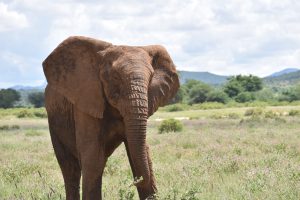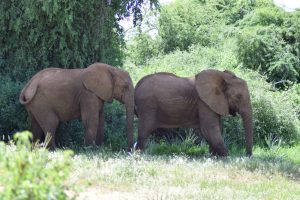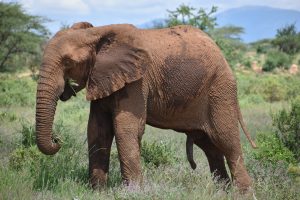
The tuskless male elephant from the Hawaiian Islands family in Kenya’s Samburu National Reserve. © Olympia Brule/Save the Elephants
Save the Elephants (STE) researchers have uncovered what is believed to be the first publicly documented case of a male African elephant born without tusks. This intriguing discovery, published as a scientific study in yesterday’s publication of Pachyderm, challenges established genetic evidence suggesting that only females are born tuskless.
The 13-year-old tuskless male, from a family known as the Hawaiian Islands, was first discovered in 2011 as a very young calf by STE’s Director of Field Operations, David Daballen in Samburu National Reserve, northern Kenya. Although researchers continued to monitor his progress, he never grew any semblance of tusks – a feature that normally emerges around the age of two and a half years. Moreover, his mother, named Kauai, is also tuskless, leaving scientists to question whether he inherited the tuskless condition from her.

The mother of the tuskless male elephant (right) with her calf when he was 13 years old. © Alice Clark/Save the Elephants
Tuskless elephants have regrettably become a common sight in several parts of Africa. This is largely due to the targeted killing of individuals with tusks by ivory poachers. Tuskless individuals often manage to avoid the slaughter, passing on this trait to the next generation. This proliferation of tusklessness is evident in a study conducted at Gorongosa National Park in Mozambique.
The researchers in Gorongosa also found that the tuskless condition can indeed be genetically inherited, but only from mothers to daughters, as the gene determining the presence or absence of tusks is linked to the X chromosome and is lethal to males – meaning that a tuskless male is never born.
One hypothesis outlined in Save the Elephants’ recently published research paper is that the tuskless male found in Samburu may be an elephant counterpart to a Klinefelter human being. The Klinefelter syndrome, which affects a small percentage of humans (approximately 1 in 10 000 men), derives from the presence of an extra X chromosome in genetic males, and often leads to a mosaic of masculine and feminine traits on different parts of the body.
Says Save the Elephants’ Research Manager, Giacomo D’Ammando. “The presence of a tuskless male African elephant is a mystery and appears to defy established genetic evidence. One possible explanation is that different genetic mechanisms operate in different elephant populations. In Asian elephants, for example, males are commonly tuskless, indicating that the tuskless condition is not lethal to them. Maybe this is what is happening in the Samburu population, and in others where tuskless males have been sighted.”

The Hawaiian Islands tuskless male elephant foraging in Samburu National Reserve at 13 years of age. © Olympia Brule/Save the Elephants
Unraveling this mystery will require further genetic evidence. Save the Elephants is now appealing to the elephant research community in Africa to provide evidence of congenital male tusklessness in savanna elephant bulls. These contributions will assist STE in establishing a comprehensive database that will help map the distribution of tuskless male elephants on the African continent, and understand whether or not the male tuskless condition is restricted to certain populations or connected with environmental characteristics. In the long term, we hope to conduct genetic investigations on these tuskless bulls, in order to determine whether or not male tusklessness is an inherited condition. Anyone with a photograph or video of a tuskless male African elephant is encouraged to send it, along with details about the location of the sighting and any additional information, to [email protected].
Learn more about the discovery in the full paper – “A possible case of congenital tusklessness in a male African elephant.”

